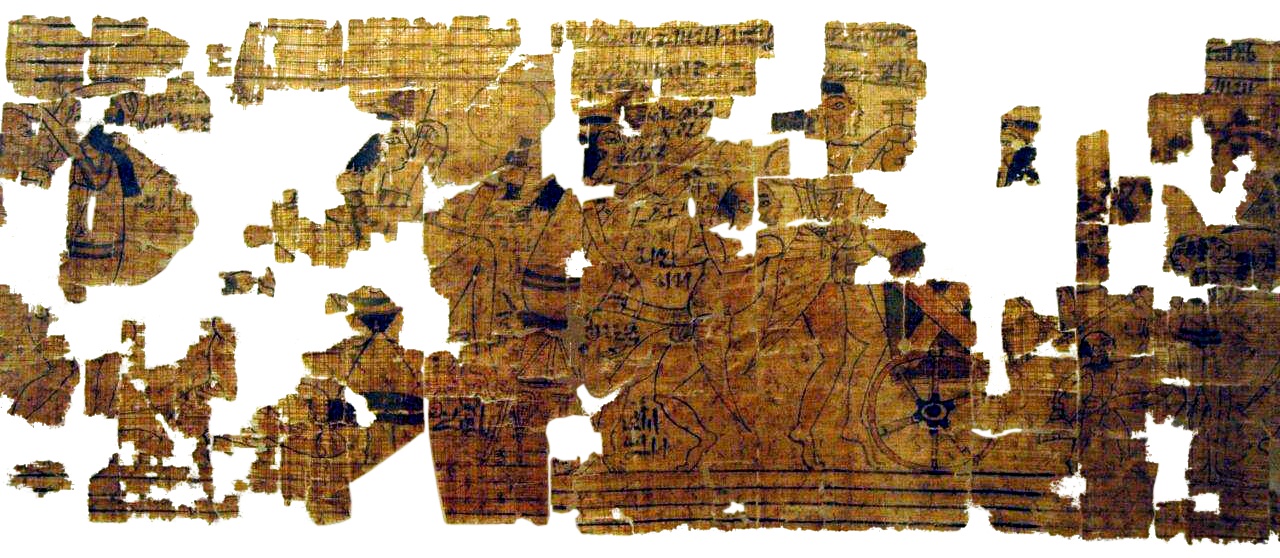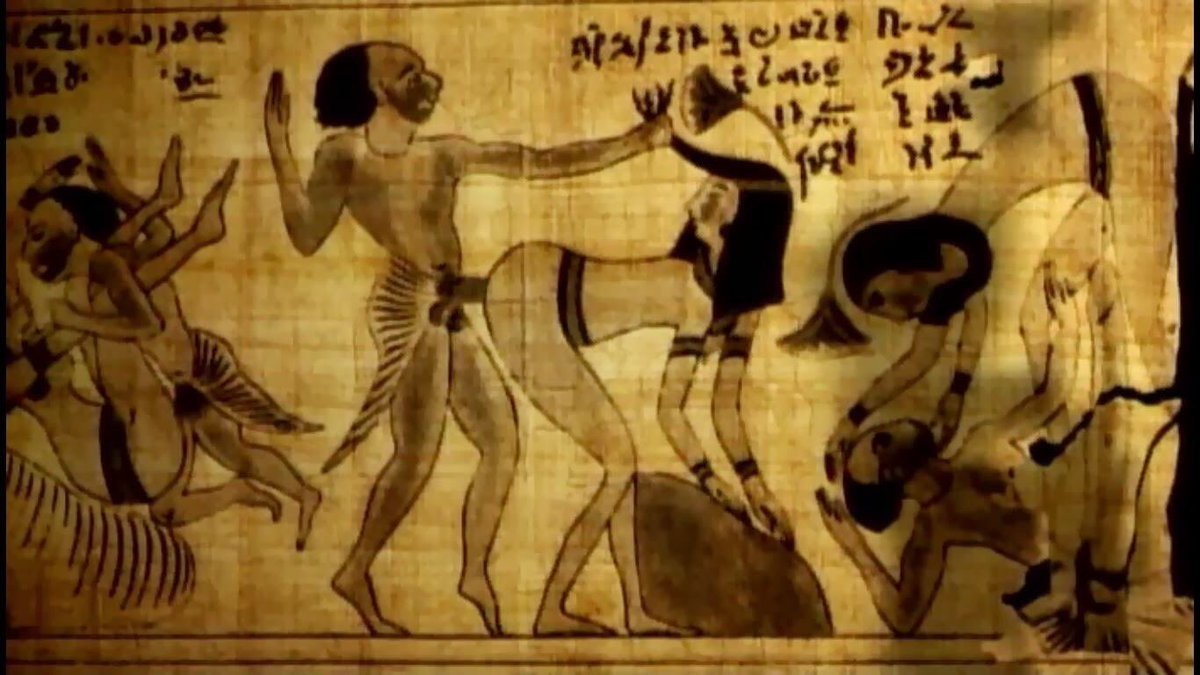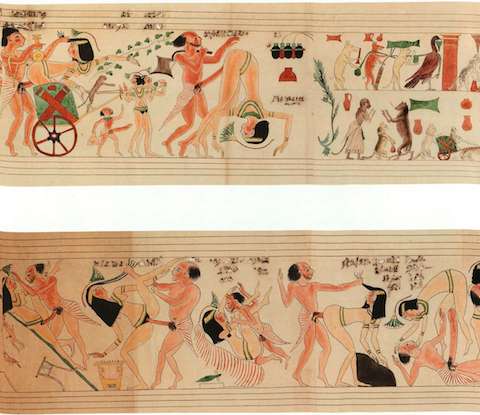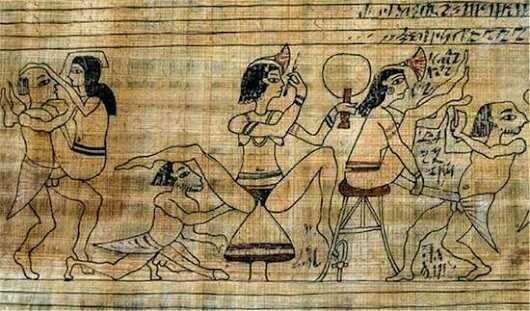The Turin Erotic Papyrus: Ancient Egypt’s Risqué Art
The Turin Erotic Papyrus (Papyrus 55001) is a peculiar artifact that stands out in the annals of ancient Egyptian art. Created around 1150 B.C. during the Ramesside Period, this scroll was discovered in Deir el-Medina in the early 19th century. Measuring a striking 8.5 feet in length and 10 inches wide, it consists of two distinct sections. Its unusual subject matter and humorous tones have led some to dub it the “world’s first men’s magazine”—though that title is likely tongue-in-cheek.
Get your dose of History via Email
Today, the papyrus is housed in the Museo Egizio in Turin, Italy, where its intricate and often bawdy illustrations are preserved for modern audiences.

Animals at Work: The Satirical First Section
The first third of the Turin Papyrus depicts animals engaging in human activities. While it might sound tame, this part of the scroll is filled with satirical humor. Animals are shown performing tasks that ancient Egyptians would find ridiculous, which seems to have been the artist’s intent. Whether it’s a donkey acting as a scribe or a lion brewing beer, the scenes are meant to entertain rather than provoke.
This section has been interpreted as a playful commentary on human behavior, exaggerated through the lens of the animal kingdom. Think of it as the ancient Egyptian equivalent of political cartoons.

The Erotic Scenes: A Surprising Departure
The remaining two-thirds of the papyrus, however, take a very different turn. This part of the scroll features twelve erotic vignettes. In these, men and women are shown in various sexual positions. The men depicted are far from the usual standards of beauty in Egyptian art. They are described as balding, overweight, and scruffy, yet they have exaggerated genitalia. The women, on the other hand, are nubile and youthful, often adorned with objects associated with love and sexuality.
The women’s use of convolvulus leaves and items linked to the goddess Hathor, like lotus flowers and sistra, suggests that these images drew from familiar erotic iconography of the time. Hathor was revered as the goddess of love, and her symbols appear throughout the scenes, possibly to add layers of meaning to the otherwise straightforward images of desire.
An Art for the Wealthy or the Scribes?
The artistic quality of the Erotic Papyrus is remarkable. The figures are finely detailed, leading many scholars to believe that this was not a casual piece of work. It may have been created for a wealthy patron, or perhaps by a group of scribes for their own amusement. The fact that no other similar scrolls have been found suggests that this was a unique creation, either meant as a one-off novelty or as a special commission.
Interestingly, while this scroll is the only surviving erotic work of its kind, sketches of sexual scenes have been found on pottery shards and in graffiti. So while sex wasn’t a common theme in Egyptian formal art, it wasn’t entirely absent from everyday life.

Breaking Misconceptions About Egyptian Art
Modern audiences often think of ancient Egyptian art as serious, with a focus on death, gods, and pharaohs. But the Turin Erotic Papyrus challenges that perception. In 1824, Jean-François Champollion, the father of Egyptology, saw the papyrus in Turin and described it as “monstrous obscenity.” His reaction reflects the shock many still feel when confronted with this unexpected side of Egyptian culture.
Despite its graphic nature, the scroll may not have been intended for sexual arousal. According to French Egyptologist Pascal Vernus, the absurdity of the scenes—especially when taken alongside the animals from the first section—suggests a satirical purpose. It’s possible that the scroll was meant to amuse aristocrats by poking fun at the sexual transgressions of the elite.
A Puzzle Without a Solution
The true purpose of the Erotic Papyrus remains a mystery. The few fragments of text that accompany the images do little to clarify its meaning. One surviving line, written hastily in the margins, speaks of love in an abstract, poetic way:
“…come behind me with your love, Oh! Sun, you have found out my heart, it is agreeable work…”
This text, however, offers no clear explanation of the scroll’s deeper intent. Was it a playful gift? A work of satire? Or something entirely different? We may never know for sure.
Conclusion: A Glimpse into the Playful Side of Ancient Egypt
The Turin Erotic Papyrus gives us a rare look at the lighter, more humorous side of ancient Egyptian society. While its erotic content might be shocking to some, it was likely intended to entertain. Whether it was through the satire of animals performing human tasks or the exaggerated sexuality of its characters, the papyrus seems designed to amuse rather than titillate.
This artifact reminds us that the ancient world was complex. Egyptians were not just builders of tombs and temples. They had humor, they had desires, and, as this papyrus shows, they had a sense of the absurd that still resonates today.
Sources:
Neural Pathways is a collective of seasoned experts and researchers with a profound passion for unraveling the enigmas of ancient history and artifacts. With a wealth of combined experience spanning decades, Neural Pathways has established itself as a leading voice in the realm of archaeological exploration and interpretation.

